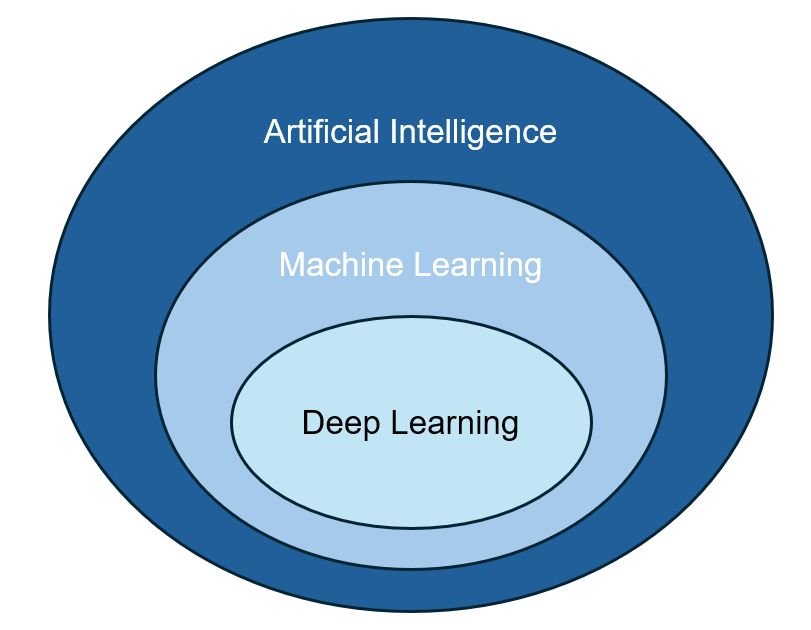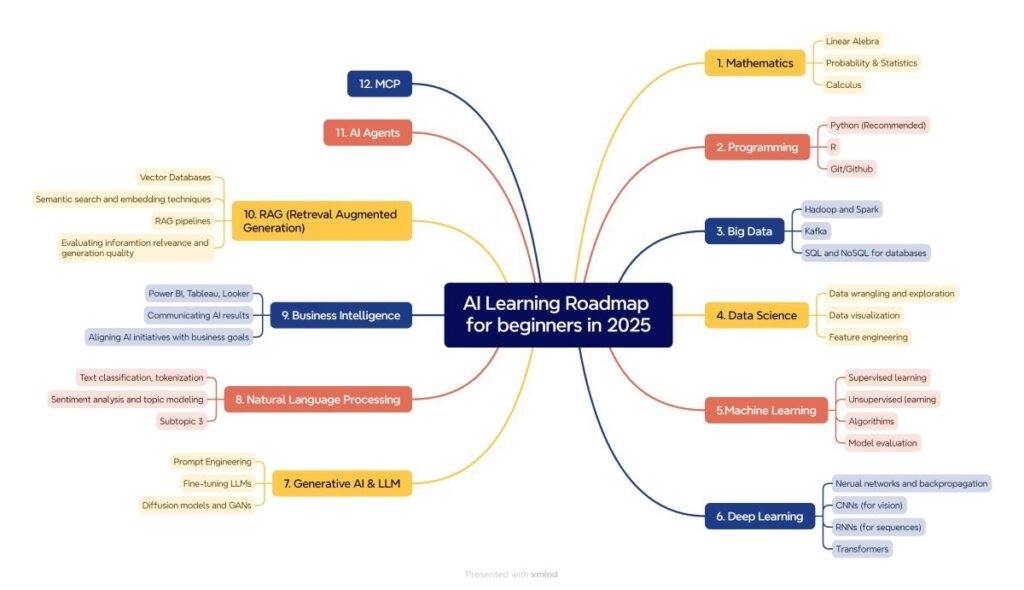In this guide, we’ll walk you through the ultimate AI learning roadmap in 2025 — tailored for self-learners and beginners — covering essential concepts, tools, resources, and practical steps to start your AI journey today.
Artificial Intelligence (AI) is no longer just a buzzword — it’s the backbone of today’s digital revolution. From personalized recommendations on Netflix and autonomous vehicles to virtual assistants like ChatGPT, AI is shaping how we work, learn, and live. In 2025, AI continues to be one of the most transformative and in-demand technologies across every industry — including healthcare, finance, retail, education, manufacturing, and creative arts.
So, why should you start learning AI now?
Whether you’re a student, a career switcher, or an entrepreneur, learning AI in 2025 gives you a front-row seat to the future. With the explosion of online courses, open-source tools, and communities, self-learning AI has never been more accessible. Unlike in the past, you don’t need a PhD or a background in computer science to get started. Today, anyone with curiosity and commitment can build smart solutions, analyze big data, or even train their own language models.
By learning AI, you future-proof your skills, unlock high-paying job opportunities, and gain the power to solve real-world problems with intelligent systems. It’s not just about coding — it’s about thinking in terms of data, automation, and innovation.
Core Concepts of Artificial Intelligence
Before diving into tools and resources, it’s important to build a strong foundation. Understanding the core concepts of Artificial Intelligence (AI) will not only help you follow advanced topics more easily but also enable you to make better decisions about what to learn next. In 2025, with the rapid pace of development, grasping these fundamental ideas early is essential for long-term success in AI.
1. Artificial Intelligence vs. Machine Learning vs. Deep Learning
Let’s start by clearing up the confusion between the terms often used interchangeably:
- Artificial Intelligence (AI): The broad field of creating machines that can mimic human intelligence — including reasoning, learning, problem-solving, perception, and language understanding.
- Machine Learning (ML): A subset of AI that enables machines to learn from data without being explicitly programmed. It includes supervised, unsupervised, and reinforcement learning.
- Deep Learning (DL): A subfield of ML that uses neural networks with many layers to process large amounts of data — especially useful in image recognition, natural language processing, and generative models.
👉 Key takeaway: AI is the umbrella term, ML is a method to achieve AI, and DL is a powerful technique within ML.

2. Data and Features
AI models are data-driven. Understanding how data is collected, cleaned, and used is essential.
- Structured vs. Unstructured Data: AI systems process both types — numbers and labels (structured), or text, images, and audio (unstructured).
- Features: These are measurable properties or characteristics of the data. Choosing the right features greatly affects model performance.
👉 Key takeaway: Data is the fuel of AI — better data leads to smarter systems.
3. Supervised, Unsupervised, and Reinforcement Learning
These are the three primary learning paradigms in machine learning:
- Supervised Learning: The model learns from labeled data (e.g., predicting house prices based on size and location).
- Unsupervised Learning: The model finds patterns in unlabeled data (e.g., customer segmentation).
- Reinforcement Learning: The model learns through trial and error by receiving rewards or penalties (e.g., AI agents in games or robotics).
👉 Key takeaway: Most beginners start with supervised learning as it’s more intuitive and easier to understand.
4. Neural Networks and Deep Learning
- Neural Networks are modeled after the human brain and consist of interconnected layers of nodes (neurons).
- Deep Learning involves networks with multiple layers (deep neural networks), enabling machines to learn complex representations.
Popular architectures include:
- Convolutional Neural Networks (CNNs) for image processing.
- Recurrent Neural Networks (RNNs) and Transformers for sequential data like text or speech.
👉 Key takeaway: Deep learning powers today’s most advanced AI systems like ChatGPT, image generators, and self-driving cars.
5. Natural Language Processing (NLP)
Natural Language Processing enables machines to understand, interpret, and generate human language.
Key NLP concepts include:
- Tokenization: Splitting text into words or phrases.
- Embeddings: Turning words into numerical vectors.
- Language Models: Predicting or generating text (e.g., GPT models).
👉 Key takeaway: NLP is one of the most exciting fields in AI, with huge applications in chatbots, translation, content creation, and search engines.
6. Computer Vision
Computer vision allows machines to interpret visual information from the world.
Common tasks:
- Image Classification: Labeling objects in images.
- Object Detection: Locating multiple objects in a frame.
- Image Generation: Creating synthetic images using GANs or diffusion models.
👉 Key takeaway: If you’re interested in self-driving cars, facial recognition, or AR, computer vision is essential.
7. Evaluation Metrics and Model Performance
To measure how well your AI model works, you need to understand evaluation metrics:
- Accuracy, Precision, Recall, F1 Score: For classification problems.
- MSE (Mean Squared Error), R²: For regression.
- Confusion Matrix: A tool for analyzing classification errors.
👉 Key takeaway: Without the right metrics, it’s hard to improve your AI model effectively.
8. Ethics, Bias, and Explainability
Modern AI isn’t just about algorithms — it’s also about responsibility.
Important ethical topics:
- Bias in Data: AI systems can reflect and amplify social biases.
- Explainability: Understanding why a model makes a certain prediction.
- Privacy: Responsible handling of user data.
👉 Key takeaway: AI should be fair, transparent, and trustworthy — especially in real-world applications.
AI Learning Roadmap for Beginners in 2025
With so many resources available, learning AI in 2025 has never been more accessible — even if you’re starting from scratch. Whether you’re a student, a career changer, or a hobbyist, you can build your AI skills with a structured learning path and high-quality self-learning tools. This section outlines a beginner-friendly roadmap and the best platforms, courses, and communities to support your journey.
To become a successful AI Engineer in 2025, you need a blend of technical expertise, domain knowledge, and practical experience. AI is a multidisciplinary field — mastering the following skills will help you thrive in a competitive and rapidly evolving job market.

1. 🧮 Mathematics
Mathematics forms the backbone of all AI algorithms and models.
Key areas to focus on:
- Linear Algebra: Vectors, matrices, and transformations
- Probability & Statistics: Bayesian thinking, distributions, hypothesis testing
- Calculus: Gradients, optimization, and understanding backpropagation
👉 Why it matters: A solid math foundation helps you understand how models learn and improve.
2. 💻 Programming
AI development requires strong coding skills — especially in Python.
Languages & Tools to Learn:
- Python: The industry standard for AI and data science
- R: Useful for statistical analysis (optional)
- Git/GitHub: Version control and collaboration
👉 Why it matters: Writing efficient, readable, and reusable code is essential for building real-world AI applications.
3. 📊 Big Data
AI systems require large amounts of data. Big Data technologies help you store, process, and manage it effectively.
Important Tools & Frameworks:
- Hadoop and Spark
- Kafka for real-time data streaming
- SQL and NoSQL for databases
👉 Why it matters: Handling big data lets you scale AI applications and work with real-world datasets.
4. 🔬 Data Science
Data science overlaps heavily with AI and is crucial for cleaning, analyzing, and understanding data.
Skills to develop:
- Data wrangling and exploration
- Data visualization with Matplotlib, Seaborn, Power BI, or Tableau
- Feature engineering
👉 Why it matters: Great AI models start with great data — and data science helps you unlock insights.
5. 🤖 Machine Learning (ML)
This is where AI begins to come alive.
What to learn:
- Supervised and unsupervised learning
- Algorithms like linear regression, decision trees, SVMs, and k-means
- Model evaluation (accuracy, precision, recall, ROC curves)
👉 Why it matters: ML is the core engine of AI. Understanding how to train, tune, and validate models is non-negotiable.
6. 🧠 Deep Learning
Deep learning powers today’s most advanced AI systems — from autonomous vehicles to AI art.
Core topics:
- Neural networks and backpropagation
- CNNs (for vision), RNNs (for sequences), and Transformers
- Frameworks like TensorFlow, Keras, and PyTorch
👉 Why it matters: Deep learning is essential for tasks involving vision, audio, and natural language.
7. ✨ Generative AI and Large Language Models (LLMs)
Generative AI, especially LLMs like GPT-4, is redefining how machines interact with humans.
Key concepts:
- Prompt engineering
- Fine-tuning LLMs (e.g., using Hugging Face Transformers)
- Diffusion models and generative adversarial networks (GANs)
👉 Why it matters: Generative AI is at the forefront of innovation in 2025 — a must-learn for modern AI engineers.
8. 🗣️ Natural Language Processing (NLP)
NLP enables machines to understand and generate human language.
Topics to explore:
- Text classification, tokenization, and named entity recognition
- Sentiment analysis and topic modeling
- Transformer architectures (BERT, GPT, T5)
👉 Why it matters: NLP powers chatbots, translation, summarization, search engines, and more.
9. 📈 Business Intelligence
Understanding the business context and making AI insights actionable is key for impactful engineering.
Tools and skills:
- Power BI, Tableau, or Looker
- Communicating AI results to non-technical stakeholders
- Aligning AI initiatives with business goals
👉 Why it matters: AI engineers who understand both the tech and the business deliver the most value.
10. 🔍 Retrieval Augmented Generation (RAG)
What is it?
Retrieval Augmented Generation is a hybrid approach that enhances Large Language Models (LLMs) by combining text generation with dynamic information retrieval. Instead of relying solely on model training data, RAG systems retrieve relevant documents from external sources to improve response accuracy and context.
Key Skills to Learn:
- Vector databases (e.g., FAISS, Weaviate, Pinecone)
- Semantic search and embedding techniques (OpenAI, SentenceTransformers)
- Implementing RAG pipelines using LangChain or LlamaIndex
- Evaluating information relevance and generation quality
👉 Why it matters: RAG is essential for building scalable, explainable, and up-to-date AI applications like enterprise assistants, legal research tools, or academic copilots.
11. 🤖 AI Agents
What are they?
AI Agents are autonomous systems capable of perceiving their environment, reasoning, and taking actions to achieve specific goals. They can chain tasks, use tools (like APIs or browsers), and even plan multi-step objectives.
Examples: AutoGPT, AgentGPT, BabyAGI, LangGraph agents
Skills to Develop:
- Understanding agent architectures and decision loops
- Tool usage and plugin orchestration
- Memory management and persistence
- Prompt chaining and task decomposition
- Using frameworks like LangChain Agents or CrewAI
👉 Why it matters: AI Agents move beyond single-turn LLMs into multi-step, dynamic reasoning — making them vital for future workflows in automation, research, and enterprise solutions.
12. 🔄 Model Context Protocol (MCP)
What is it?
The Model Context Protocol (MCP) is an open standard introduced by Anthropic in November 2024. It provides a universal method for connecting AI models, such as large language models (LLMs), to external data sources and tools. Think of MCP as the “USB-C of AI applications”—a standardized interface that simplifies and secures the integration of AI systems with various data repositories and services.
Why it matters:
Before MCP, integrating AI models with diverse data sources required custom connectors for each combination, leading to complexity and scalability issues. MCP addresses this by offering a standardized protocol, enabling developers to build AI applications (MCP clients) that can seamlessly connect to multiple data sources exposed through MCP servers.
Key Features:
- Standardized Integration: MCP standardizes how applications provide context to LLMs, facilitating consistent and efficient communication between AI models and external data sources .
- Secure Two-Way Connections: It enables secure, bidirectional communication between AI-powered tools and data repositories, ensuring data integrity and privacy .
- Modular Architecture: Developers can either expose their data through MCP servers or build AI applications (MCP clients) that connect to these servers, promoting modular and scalable system design .
- Open-Source Support: Anthropic has released SDKs and open-source repositories for MCP servers, facilitating adoption and community-driven development.
Real-World Applications:
- Enterprise Assistants: Companies like Block use MCP to allow internal AI assistants to retrieve information from proprietary documents, CRM systems, and company knowledge bases .
- Software Development: Platforms like Replit and Sourcegraph have integrated MCP to provide coding assistants with real-time code context, enhancing developer productivity .
- Natural Language Data Access: Applications such as AI2SQL leverage MCP to connect models with SQL databases, enabling users to perform complex queries using plain language
🔥 Top AI Projects for Beginners in 2025
1. 🤖 AI Chatbot for Customer Support
Description: Develop a chatbot using Natural Language Processing (NLP) to handle common customer inquiries.
Tools: Python, Dialogflow, Rasa, ChatterBot
Why It’s Great: Chatbots are prevalent across industries, offering a practical introduction to NLP and user interaction design
2. 📰 Fake News Detection System
Description: Create a system that identifies and flags unreliable or fabricated news articles using NLP techniques.
Tools: Python, TensorFlow, Scikit-learn
Why It’s Great: Addresses the real-world issue of misinformation, enhancing your skills in text classification and model evaluation.
3. 🖼️ Handwritten Digit Recognition
Description: Build a model to recognize and classify handwritten digits, a classic computer vision task.
Tools: Python, TensorFlow, Keras, MNIST dataset
Why It’s Great: Provides a solid foundation in image processing and neural networks.
4. 🎬 Movie Recommendation System
Description: Develop a system that suggests movies to users based on their preferences and viewing history.
Tools: Python, Pandas, Scikit-learn
Why It’s Great: Introduces you to recommendation algorithms and user behavior analysis.
5. 🧾 Resume Parser
Description: Create a tool that extracts key information from resumes, such as contact details, education, and work experience.
Tools: Python, NLP libraries, Regular Expressions
Why It’s Great: Useful in HR tech, this project enhances your skills in text extraction and data structuring.
6. 🗣️ Speech-to-Text Converter
Description: Develop an application that converts spoken language into written text.
Tools: Python, Google Speech-to-Text API
Why It’s Great: Explores audio processing and real-time transcription, applicable in various domains like transcription services and voice assistants.
7. 📊 Predictive Sales Analytics
Description: Build a model that forecasts future sales based on historical data and market trends.
Tools: Python, Pandas, Scikit-learn
Why It’s Great: Applies machine learning to real-world business problems, enhancing decision-making processes.
8. 🧠 AI-Powered Personal Finance Assistant
Description: Create an assistant that tracks expenses, suggests investment strategies, and automates savings.
Tools: Python, Financial APIs, Machine Learning Libraries
Why It’s Great: Combines AI with financial literacy, offering practical benefits to users.
9. 🎨 AI-Generated Art and Design
Description: Develop a tool that creates unique artwork or assists in digital design using AI.
Tools: Python, Generative Adversarial Networks (GANs), Stable Diffusion
Why It’s Great: Explores the creative side of AI, blending technology with art.
10. 🌱 AI for Sustainable Agriculture
Description: Build a system that uses satellite imagery, weather patterns, and soil data to suggest optimal planting schedules and crop types.
Tools: Python, TensorFlow, Computer Vision Libraries
Why It’s Great: Applies AI to address environmental challenges, promoting sustainable practices.
🧠 AI Learning Roadmap – Top Self-Learning Platforms in 2025
| Platform | Strengths | Best For |
|---|---|---|
| Coursera | University-level courses, certificates | Structured learning |
| edX | MIT, Harvard content, hands-on labs | Academic background |
| Udacity | Industry nanodegrees and real-world projects | Career-focused learning |
| freeCodeCamp | Free and beginner-friendly content | Complete beginners |
| Kaggle Learn | Interactive mini-courses, datasets | Practical skill-building |
| YouTube | Tons of free tutorials (e.g., 3Blue1Brown, Sentdex, CodeBasics) | Visual learners |
🛠️ AI Learning Roadmap: Essential AI Tools & Libraries to Learn
| Tool/Library | Use Case |
|---|---|
| NumPy | Numerical operations |
| Pandas | Data manipulation |
| Scikit-learn | Classic ML algorithms |
| Matplotlib/Seaborn | Data visualization |
| TensorFlow | Deep learning |
| PyTorch | Deep learning (more flexible) |
| OpenCV | Computer vision |
| Hugging Face | NLP and pre-trained models |
Final Tip: Stay Consistent and Curious
AI is a fast-evolving field. Don’t try to learn everything at once. Focus on fundamentals, build real projects, and stay connected with the community. Allocate time every day or week to build your skills, and celebrate small wins.




